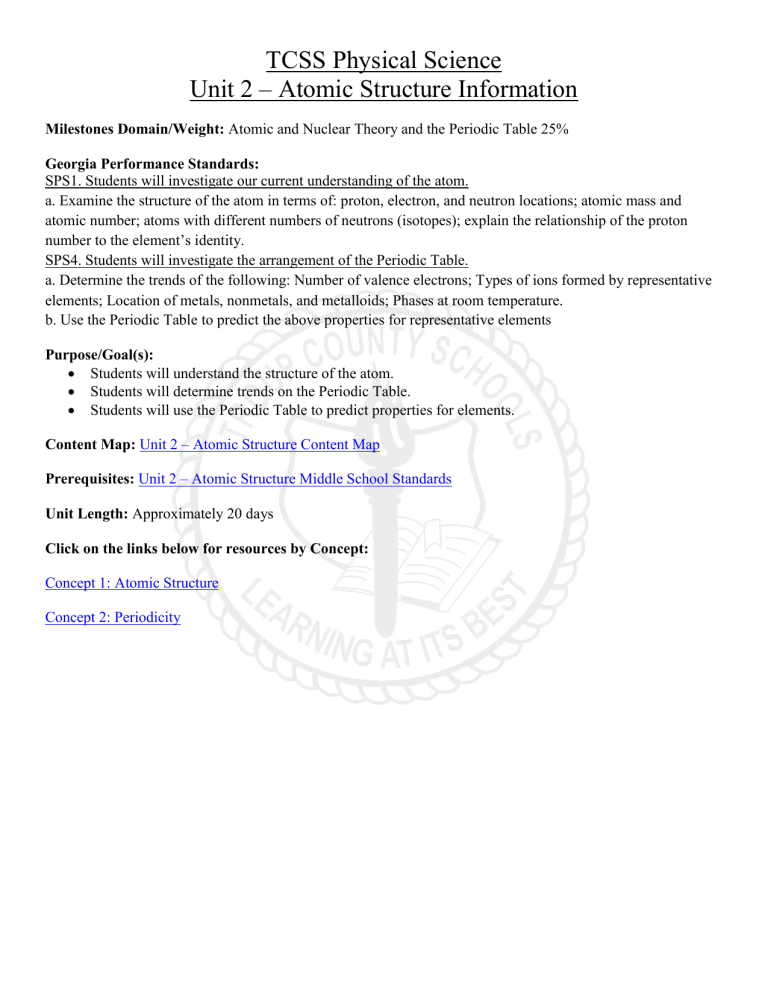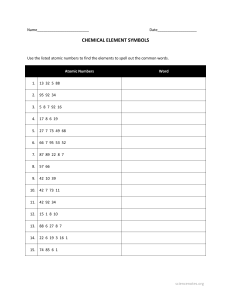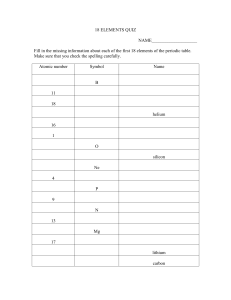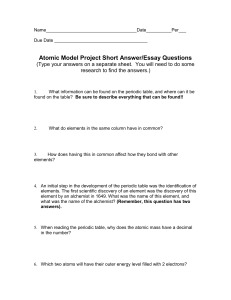
TCSS Physical Science Unit 2 – Atomic Structure Information Milestones Domain/Weight: Atomic and Nuclear Theory and the Periodic Table 25% Georgia Performance Standards: SPS1. Students will investigate our current understanding of the atom. a. Examine the structure of the atom in terms of: proton, electron, and neutron locations; atomic mass and atomic number; atoms with different numbers of neutrons (isotopes); explain the relationship of the proton number to the element’s identity. SPS4. Students will investigate the arrangement of the Periodic Table. a. Determine the trends of the following: Number of valence electrons; Types of ions formed by representative elements; Location of metals, nonmetals, and metalloids; Phases at room temperature. b. Use the Periodic Table to predict the above properties for representative elements Purpose/Goal(s): Students will understand the structure of the atom. Students will determine trends on the Periodic Table. Students will use the Periodic Table to predict properties for elements. Content Map: Unit 2 – Atomic Structure Content Map Prerequisites: Unit 2 – Atomic Structure Middle School Standards Unit Length: Approximately 20 days Click on the links below for resources by Concept: Concept 1: Atomic Structure Concept 2: Periodicity TCSS Physical Science Atomic Structure Unit Information Concept, Essential Question(s), and Standard(s) Concept 1: Atomic Structure Vocabulary Essential* Atom Atomic Mass EQ1: How do subatomic Atomic Number Electron particles of an atom affect its characteristics? Element Isotope Neutron EQ2: What properties can Proton be used to compare Proton Number subatomic particles? Supplemental** EQ3: How are isotopes of Electron Cloud Energy Level the same element Ion different? Nucleus Valence Electron EQ4: How do atoms become ions? *Essential vocabulary listed in the GPS SPS1a. Examine the Standards structure of the atom in terms of: proton, electron, **Supplemental vocabulary listed in the and neutron locations; state frameworks and/or atomic mass and atomic other state document number; atoms with different numbers of neutrons (isotopes); explain the relationship of the proton number to the element’s identity. Resources [Back to Top] Animations/Videos PhET Build an Atom PhET Isotopes and Atomic Mass Atomic Structure (2:01) – Explains the basic atomic structure and outlines the roles of protons, neutrons, and electrons Isotopes (2:06) – Explains what isotopes are, using Carbon-12, Carbon-13, and Carbon-14 as examples Notes Atomic Structure – Multi-Day PowerPoint for the atomic structure graphic organizer and isotope graphic organizer. Also, the PowerPoint includes practice question, activators and summarizers. Atomic Structure Graphic Organizer – Used with the atomic structure PowerPoint Proton, Neutron, and Electron Venn Diagram – Student copy of the Venn Diagram found in the atomic structure PowerPoint Isotope Graphic Organizer – Used with the atomic structure PowerPoint Practice/Worksheets/Labs Acrostic for Protons, Neutrons, and Electrons – Student writing assignment for protons, neutron, and electrons Isotopes Practice – Student worksheet with practice isotope problems Assessment Concept 1: Sample Assessment Items TCSS Physical Science Atomic Structure Unit Information Concept, Essential Question(s), and Standard(s) Concept 2: Periodicity EQ1: How does knowing the trends of the periodic table help scientists predict properties of the representative elements? SPS4a. Determine the trends of the following: Number of valence electrons; Types of ions formed by representative elements; Location of metals, nonmetals, and metalloids; Phases at room temperature. SPS4b. Use the Periodic Table to predict the above properties for representative elements. Vocabulary Essential* Ion Metal Metalloid Nonmetal Periodic Table Valence Electron Supplemental** Family Group Noble Gases Oxidation Number Period *Essential vocabulary listed in the GPS Standards **Supplemental vocabulary listed in the state frameworks and/or other state document Resources [Back to Top] Animations/Videos Reading the Periodic Table (2:22) – This video shows how to read the periodic table. The terms “atomic number” and “atomic mass.” Groups and Periods Song (2:48) – This song is based on the 60’s tune “Happy Together.” This song should help students remember the difference in meaning between Group Numbers and Period Numbers. Reaction (Explosion) of Alkali Metals with Water (3:15) – This video clips shows the reactions of the alkali metals with water as you move down the table. Notes Periodic Table PowerPoint – Multi-day PowerPoint for the trends on the periodic table vocabulary and periodic table graphic organizer. Trends on the Periodic Table Vocabulary – Graphic organizer for the students to fill out when the teacher uses the Periodic Table Notes PowerPoint (slides 14-29) Valence Electrons and Energy Levels Remediation – Remediation activity for students after a formative assessment Periodic Table Graphic Organizer – Visual graphic organizer for the periodic table trends to be used with the Periodic Table Notes PowerPoint (slides 31-52) Practice/Worksheets/Labs Mendeleev Lab – The students construct a rough periodic table with the cards provided and then find a “best fit” for the unknown elements. Periodic Table Practice 1 – Student activity sheet where the students determine valence electrons; energy levels; metal, nonmetal, or metalloid; and phases at room temperature Periodic Table Practice 2 – Student activity sheet where the students determine the symbol; name; atomic number; atomic mass; protons; electrons; neutrons; phase of matter; metal, nonmetal, or metalloid; energy levels; valence electrons Assessment Concept 2: Sample Assessment Items TCSS Physical Science Atomic Structure Unit Information Periodic Table Jeopardy – Jeopardy PowerPoint review for the periodic table





